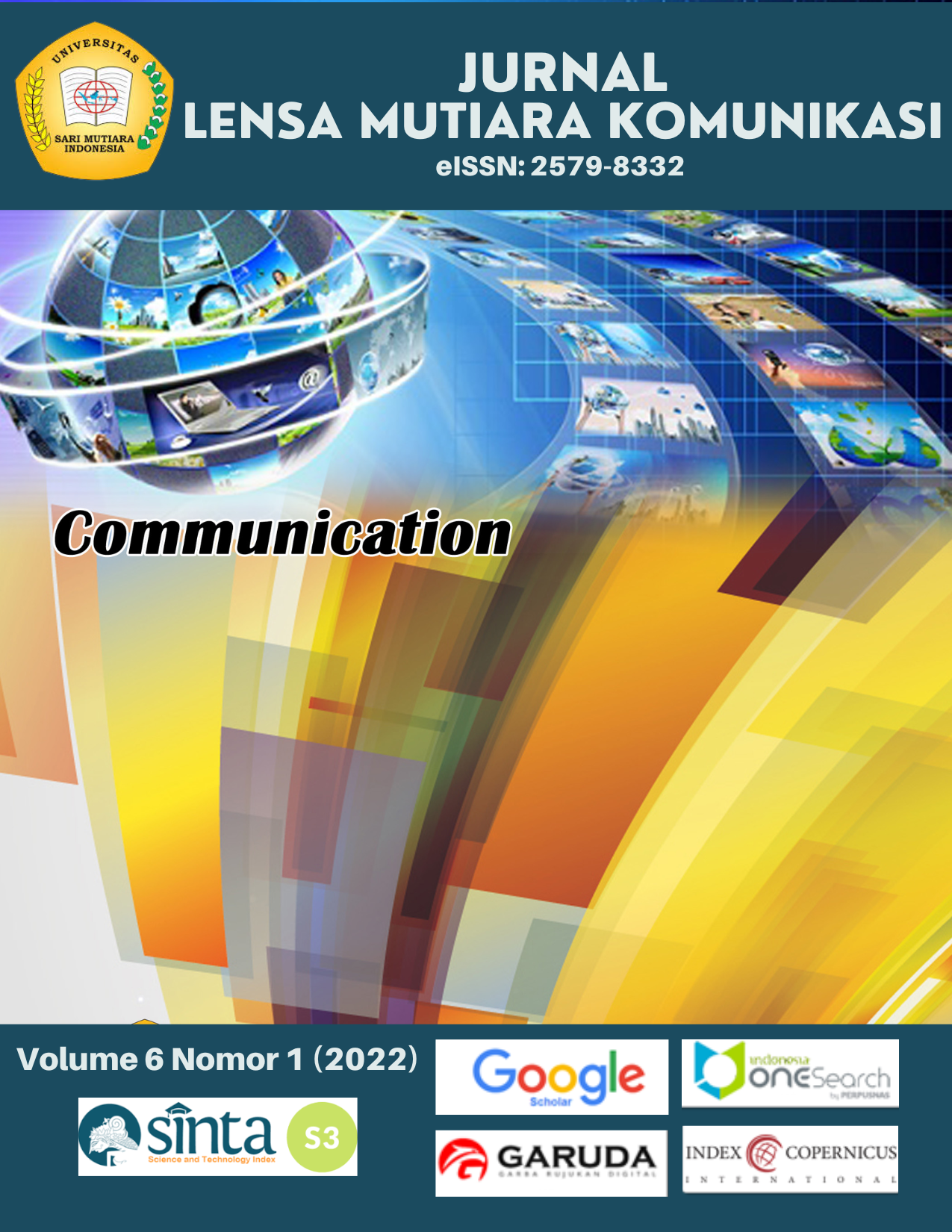Cognitive Dissonance pada Konteks Berkomunikasi dan Mencari Informasi di Ruang Digital: Fenomena Selective Exposure
DOI:
https://doi.org/10.51544/jlmk.v6i1.2535Keywords:
Cognitive Dissonanc, Selective Exposure, Filter Bubble, Echo Chamber, Social MediaAbstract
In the digital space that is now increasingly dominating our lives, there are challenges and new social situations that require us to adapt. Cognitive Dissonance Theory (CDT) places a focus on seeing human behavior in situations that are incompatible with the cognition he has. After six decades of CDT's existence, there have been many derivative concepts that can be used to analyze causation in this dissonance situation. Selective exposure is a concept derived from CDT that has received attention from researchers in analyzing the phenomenon of filter bubbles and echo chambers. To examine the application of CDT in a contemporary context, in this digital space, this study was conducted by making a literature review that focuses on elaborating on the theory and context of CDT in use. Using qualitative content analysis from a collection of previous studies, this study maps the relevance of theory to the context of situations in the digital space. The conclusion is that CDT, both based on basic assumptions and derived concepts tested by other researchers, can objectively predict the cause-and-effect of a situation that triggers dissonance in a person's cognition when a situation with similar conditions occurs.
Downloads
References
Ambos, T. C., & Birkinshaw, J. 2010. How do ventures evolve? An inductive study of archetype changes in science-based ventures. Organization Science, 21: 1125-1140.
An, J., Quercia, D., & Crowcroft, J. (2013). Why individuals seek diverse opinions (or why they don't). In Proceedings of the 5th Annual ACM Web Science Conference (pp. 15-18).
Aronson, E., Fried, C., & Stone, J. (1991). AIDS prevention and dissonance: A new twist on an old theory. American Journal of Public Health, 81, 1636-1638.
Bhave, D. P., & Glomb, T. M. 2016. The role of occupational emotional labor requirements on the surface acting–job satisfaction relationship. Journal of Management, 42: 722-741
Brooksbank, R., & Fullerton, S. (2020). Cognitive dissonance revisited. Asia Pacific Journal Of Marketing And Logistics, 32(8), 1759-1782. doi: 10.1108/apjml-01-2019-0068
Charles, A. (2014). Post-purchase consumer regret effect on customer satisfaction. European Journal of Business and Management, Vol. 6 No. 8, pp. 104-110.
Chaffee, S. H., Saphir, M. N., Graf, J., Sandvig, C, & Hahn, K. S. (2001). Attention to counter-attitudinal messages in a state election campaign. Political Communication, 18(3), 247–272. http://dx.doi.org/10.1037/0022-3514.94.1.1
Chaplin, J.P. (1968), Dictionary of Psychology, Dell Publishing, New York, USA.
Chen W., Hung P.C., Chen C.K., & Pan, H.S. (2020). Understanding Consumers' Post-Purchase Dissonance by Online Impulse Buying-Beauty Product. Proceedings of the 2020 International Conference on Management of e-Commerce and e-Government (ICMECG 2020). Association for Computing Machinery, New York, NY, USA, 46–51. DOI:https://doi.org/10.1145/3409891.3409910
Cheng, J., Burke M., & Davis, E.G. (2019). Understanding Perceptions of Problematic Facebook Use: When People Experience Negative Life Impact and a Lack of Control. Proceedings of the 2019 CHI Conference on Human Factors in Computing Systems (CHI '19). Association for Computing Machinery, New York, NY, USA, Paper 199, 1–13. DOI:https://doi.org/10.1145/3290605.3300429
Chefitz, M., Austin-Breneman, J., & Melville, N. (2018). Designing Conversational Interfaces to Reduce Dissonance. Proceedings of the 2018 ACM Conference Companion Publication on Designing Interactive Systems (pp. 219-223).
Cooper, J. (2012), “Cognitive dissonance theory”, in Lange, P.A.M., Kruglanski, A.W.T. and Higgins, E.T. (Eds), Handbook of Theories of Social Psychology, Sage, Thousand Oaks, USA, pp. 377-397
Dickerson, C. A., Thibodeau, R., Aronson, E., & Miller, D. (1992). Using cognitive dissonance to encourage water conservation 1. Journal of applied social psychology, 22(11), 841-854.
Dewanti, I. N., & Irwansyah, I. (2021). Disonansi Kognitif Dalam Perilaku Konsumen Masyarakat Indonesia Terhadap Pembelian Produk Tanpa Logo Halal. Jurnal Lensa Mutiara Komunikasi, 5(1), 99-109.
Faridani, S., Bitton, E., Ryokai, K., & Goldberg, K. (2010). Opinion space: a scalable tool for browsing online comments. In Proceedings of the SIGCHI Conference on Human Factors in Computing Systems (pp. 1175-1184).
Ferron, M., & Massa, P. (2013). Transtheoretical model for designing technologies supporting an active lifestyle. In Proceedings of the Biannual Conference of the Italian Chapter of SIGCHI (pp. 1-8).
Frey, D. (1986). Recent research on selective exposure to information. Advances in experimental social psychology, 19, 41-80.
Harmon-Jones, E., Harmon-Jones, C., Fearn, M., Sigelman, J., & Johnson, P. (2008). Left frontal cortical activation and spreading of alternatives: tests of the action-based model of dissonance. Journal of Personality and Social Psychology, 94(1), 1–15
Gao, M., Xiao, Z., Karahalios, K., & Fu, W. (2018). To Label or Not to Label: The Effect of Stance and Credibility Labels on Readers’ Selection and Perception of News Articles. Proceedings Of The ACM On Human-Computer Interaction, 2(CSCW), 1-16. doi: 10.1145/3274324
Garrett, R. K. (2009). Politically motivated reinforcement seeking: Reframing the selective exposure debate. Journal of Communication, 59(4), 676–699. doi:10.1111/j.1460-2466.2009.01452.x
George, B. P., & Yaoyuneyong, G. (2010). Impulse buying and cognitive dissonance: a study conducted among the spring break student shoppers. Young Consumers.
Griffin, E. A., Ledbetter, A., & Sparks, G. G. (2019). A first look at communication theory.
Hinojosa, A. S., Gardner, W. L., Walker, H. J., Cogliser, C., & Gullifor, D. (2017). A review of cognitive dissonance theory in management research: Opportunities for further development. Journal of Management, 43(1), 170-199.
Jiang, Y., Liao, Q. V., Cheng, Q., Berlin, R. B., & Schatz, B. R. (2012). Designing and evaluating a clustering system for organizing and integrating patient drug outcomes in personal health messages. In AMIA Annual Symposium Proceedings (Vol. 2012, p. 417). American Medical Informatics Association.
Klapper, J. T. (1960). The effects of mass communication. Glencoe, IL: The Free Press.
Kriplean, T., Morgan, J., Freelon, D., Borning, A., & Bennett, L. (2012). Supporting reflective public thought with considerit. In Proceedings of the ACM 2012 conference on Computer Supported Cooperative Work (pp. 265-274).
Kunda, Z. (1990). The case for motivated reasoning. Psychological Bulletin, 108(3), 480–498.http://dx.doi.org/10.1037/0033-2909.108.3.480
Liao, Q. V., & Fu, W. T. (2013). Beyond the filter bubble: Interactive effects of perceived threat and topic involvement on selective exposure to information. In CHI 2013: Changing Perspectives, Conference Proceedings - The 31st Annual CHI Conference on Human Factors in Computing Systems (pp. 2359-2368). (Conference on Human Factors in Computing Systems - Proceedings). https://doi.org/10.1145/2470654.2481326
Liu, Y., Li, H., Xu, X., Kostakos, V., & Heikkilä, J. (2016). Modeling consumer switching behavior in social network games by exploring consumer cognitive dissonance and change experience. Industrial Management & Data Systems.
Liu, F., Xiao, B., Lim, E. T., & Tan, C. W. (2017). Investigating the impact of gender differences on alleviating distrust via electronic word-of-mouth. Industrial Management & Data Systems.
Metin, I., & Camgoz, S. M. (2011). The advances in the history of cognitive dissonance theory. International Journal of Humanities and Social Science, 1(6), 131-136.
Nel, E., Helmreich, R., & Aronson, E. (1969). Opinion change in the advocate as a function of the persuasibility of his audience: A clarification of the meaning of dissonance. Journal of Personality and Social Psychology, 12(2), 117.
Oh, A. H., Lee, H. J., & Kim, Y. M. (2009). User Evaluation of a System for Classifying and Displaying Political Viewpoints of Weblogs. In ICWSM.
Park, S., Kang, S., Chung, S., & Song, J. (2009, April). NewsCube: delivering multiple aspects of news to mitigate media bias. In Proceedings of the SIGCHI conference on human factors in computing systems (pp. 443-452)
Powers, T. L., & Jack, E. P. (2013). The influence of cognitive dissonance on retail product returns. Psychology & marketing. 30(8), 724-735.
Sharifi, S. S., & Esfidani, M. R. (2014). The impacts of relationship marketing on cognitive dissonance, satisfaction, and loyalty. International Journal of Retail & Distribution Management.
Shipp, A. J., Furst-Holloway, S., Harris, T. B., & Rosen, B. 2014. Gone today but here tomorrow: Extending the unfolding model of turnover to consider boomerang employees. Personnel Psychology, 67: 421-462.
Sigall, H. (2017). Buyer’s remorse: the consequences of your decisions. Psychology Today, August 7. Retrieved from: http://psychologytoday.com/us/blog/wishful-thoughts/201708/buyer-s-remorse (accessed 8 August 2018).
Sunstein, C. R. (2018). # Republic: Divided democracy in the age of social media. Princeton University Press.
Tsang, S.J. (2019). Cognitive Discrepancy, Dissonance, and Selective Exposure, Media Psychology, 22:3, 394-417, DOI: 10.1080/15213269.2017.1282873
Tzeng, S.Y. and Shiu J.Y. (2019), “Regret type matters: risk aversion and complaining in a multidimensional post purchase regret framework”, Asia Pacific Journal of Marketing and Logistics, Vol. 31 No. 5, pp. 1466-1485.
Liao, T.H. (2017). Online shopping post-payment dissonance. International Journal of Information Management 37, 6 (December 2017), 520–538. DOI: https://doi.org/10.1016/j.ijinfomgt.2017.03.006
Westphal, J. D., & Bednar, M. K. 2008. The pacification of institutional investors. Administrative Science Quarterly, 53: 29-72.
Wiafe, I., Nakata, K. & Gulliver, S. (2014). Categorizing users in behavior change support systems based on cognitive dissonance. Pers Ubiquit Comput 18, 1677–1687 https://doi.org/10.1007/s00779-014-0782-3
Yatani, K., Novati, M., Trusty, A., & Truong, K. N. (2011). Review spotlight: a user interface for summarizing user-generated reviews using adjective-noun word pairs. In Proceedings of the SIGCHI Conference on Human Factors in Computing Systems (pp. 1541-1550).


















